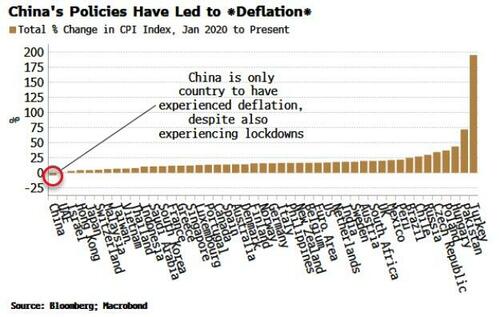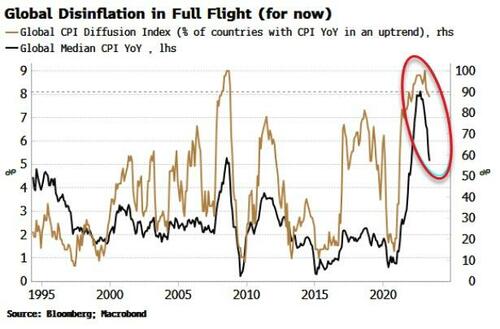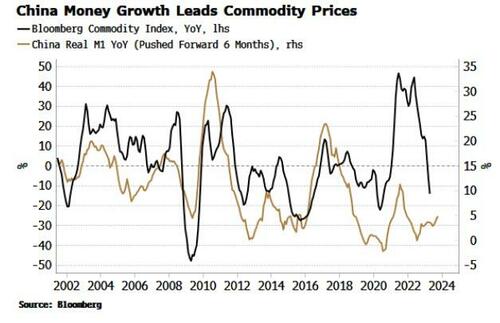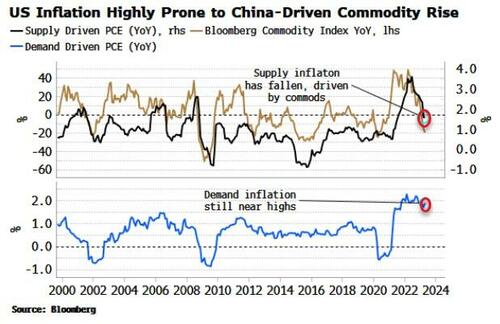Economics
Fed Hawkishness Will Be Kept At Bay By China’s Angst
Fed Hawkishness Will Be Kept At Bay By China’s Angst
Authored by Simon White, Bloomberg macro strategist,
China’s faltering recovery will…

Fed Hawkishness Will Be Kept At Bay By China’s Angst
Authored by Simon White, Bloomberg macro strategist,
China’s faltering recovery will restrain US and global inflation, further capping already-fading Federal Reserve hawkishness.
It was supposed to be “revenge spending” that did it. After almost three years of lockdown, the ending of restrictions in China was expected to unleash a flood of repressed consumers ready to splurge.
But if revenge is a dish best served cold, no-one’s eating it. China is in the midst of yet another false start to its recovery amid a deteriorating economic backdrop.
This has knock-on effects for the US and the rest of the world. Global inflation will remain on the soft side while still-subdued monetary stimulus will keep a lid on commodity prices. A re-acceleration in US inflation will be deferred, raising the possibility the Fed is at its peak rate.
The chart below starkly illustrates China’s diverging set of fortunes. Despite experiencing supply-and-demand-disrupting lockdowns along with everyone else, China is the only country to have seen consumer deflation since the beginning of 2020. Almost every other country has seen its largest price rises in decades.
For China’s recovery to evolve from a stumble to a run, more stimulus will be required, which will lead to rising consumer inflation, higher commodity prices, and thus a re-acceleration in global inflation.
This may seem like thinking too many steps ahead, but the fact is global disinflation is now in full swing, and therefore increasingly priced in by money markets and inflation-fixing swaps. The market upset will come when disinflation slows and price growth starts rising again.
Understanding why China has seen consumer deflation – when everyone else had the opposite – illuminates what is likely to happen next in the cycle.
During the pandemic, DM countries focused on protecting jobs and stimulating consumption. Many EMs had only nominal lockdowns as their finances were not in a position to backstop their economies. China, on the other hand, had stringent restrictions and gave little support to workers and consumers.
In short, China resorted to what it knows best, which is going for the low-hanging fruit of export-orientated growth at the expense of the household sector.
We can see this in China’s trade. Exports, predictably, surged in response to China’s pandemic stimulus. In a more balanced economy, some of this income would spread to the household sector, the largest net importer, and imports would rise too. Except imports in China stagnated even as exports rose to new highs. The wealth was not being spread.
Now exports are slowing as China hits the limits of what the world is currently willing to import. Unemployment is creeping higher, at just under 4%, but this obscures the more worrying picture in youth unemployment, rising fast and now over 20%.
China will be forced at some point to stimulate in a way that floats all boats, so-called flood-like stimulus.
That sort of easing is a big deal for China, and for the rest of the world. It was flood-like stimulus that meant China was responsible for 70% of the world’s money growth in the immediate aftermath of the GFC. It’s not hyperbole to suggest that without China, the global economy would have entered a depression.
But high debt levels and a reluctance to re-buoy the shadow-finance sector are likely staying China’s hand for now. But when job losses become too large to stomach, policy makers will relent.
We’ll know this has happened when we see a significant upturn in real M1 growth. Real M1’s inability to gain much momentum tells us why the recovery has yet to get going. But as the chart below shows, when it does it also means commodities should begin rising again.
Falling commodity prices have driven most of the decline in US headline inflation. The chart below shows headline PCE inflation split up into supply and demand components. As can be seen, the demand component has barely budged from its highs, while supply inflation – driven by commodities – has been responsible for most of the fall seen in the headline number.
The flip side is that an increase in commodity prices would quickly re-inforce still-elevated demand inflation and lead to a re-acceleration in US (and global) price growth.
China’s unemployment rate and other growth data will be key in gauging when policy makers are likely to significantly boost stimulus. Until then, the Fed and other central banks will probably become more risk averse – balancing growth concerns with the inflation outlook – with the (current) peak in rates very close (if not already here in the case of the Fed).
The faltering recovery in China will allow the Fed and other central banks to step back and perhaps even ease. But the inflation truce will only be temporary, and the underlying dynamics are such that they will have to return to the battle later in the cycle.
Tyler Durden
Thu, 06/01/2023 – 11:15
inflation
deflation
commodities
commodity
monetary
markets
reserve
policy
fed

Argentina Is One of the Most Regulated Countries in the World
In the coming days and weeks, we can expect further, far‐reaching reform proposals that will go through the Argentine congress.
Crypto, Crude, & Crap Stocks Rally As Yield Curve Steepens, Rate-Cut Hopes Soar
Crypto, Crude, & Crap Stocks Rally As Yield Curve Steepens, Rate-Cut Hopes Soar
A weird week of macro data – strong jobless claims but…
Fed Pivot: A Blend of Confidence and Folly
Fed Pivot: Charting a New Course in Economic Strategy Dec 22, 2023 Introduction In the dynamic world of economics, the Federal Reserve, the central bank…























